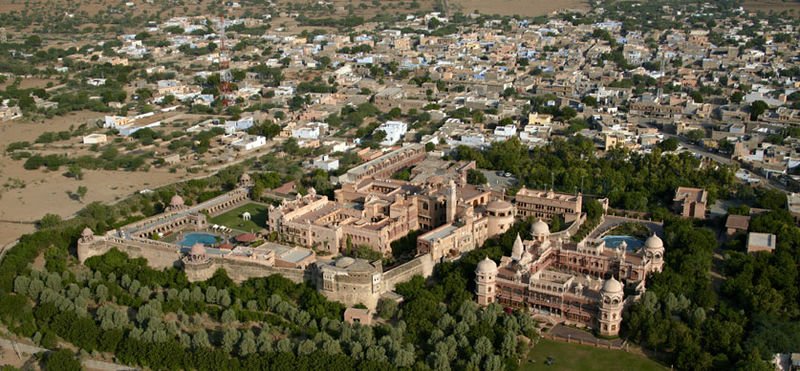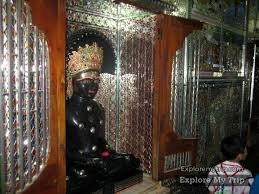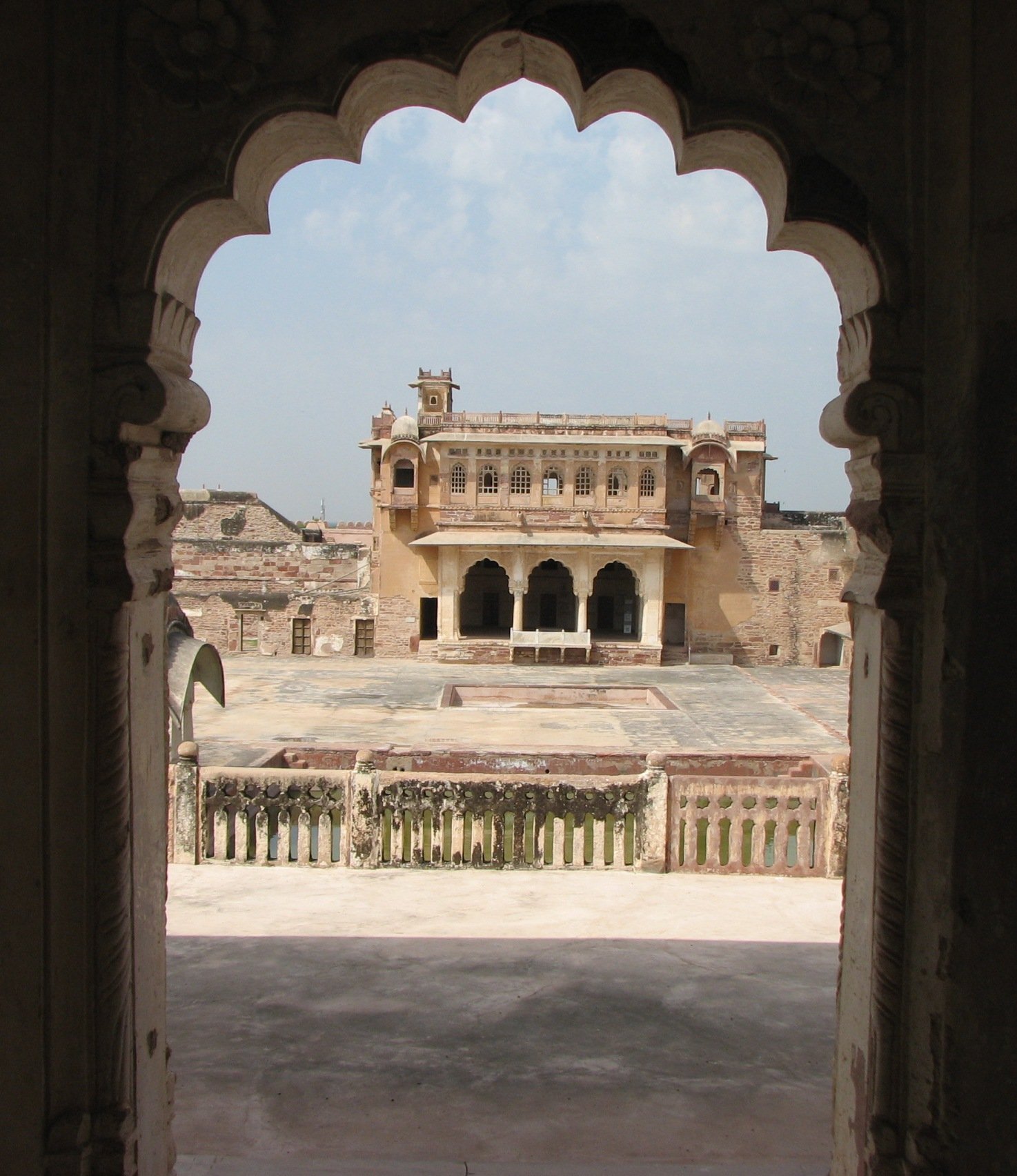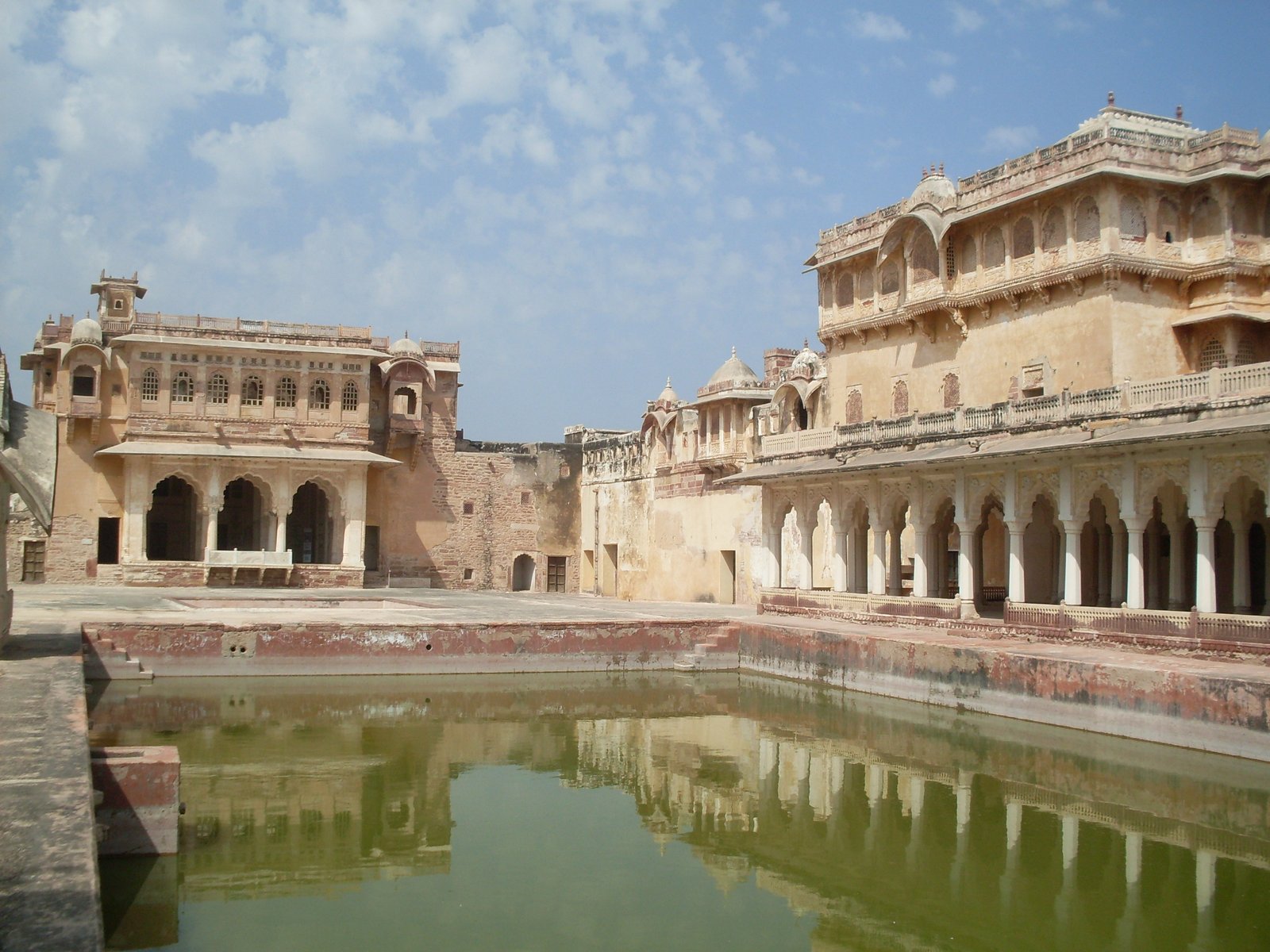
Khimsar Fort is located near Khinvsar village, in the Nagaur district of Rajasthan in India, halfway between Jodhpur and Nagaur, on the eastern edge of the Thar Desert. The fortress was built in 1523 by Rao Karamsji, the 8th son of Rao Jodha of Jodhpur.

he Jain Glass temple is located just behind the Kamla Tower of Nagaur in the region of the Maheshwari Mahal. The temple is uniquely made of glass and enamel work on the ceilings, floors, panels, pillars and doors that are not seen in rest of the temples in India. All the glass works within the temple represents the precision and ancient art in the form of Jain scriptures.
The temple interiors are decorated with ornamental arches and rare marble works that are visible as soon as one enters the temple. The temple houses different figures of Lord Mahavira along with 23 Jain Tirthankaras that are placed comfortably on the higher pedestals. This temple is of utmost importance to the Jain communities.

The main attraction here is the Ahchitragarh Fort, which was in turn controlled by Rajputs, Mughals and the British. It’s more of a pleasure palace with a touch of delicacy to the buildings. There’s a Hawa Mahal, Diwan-i-Khas, Akbari Mahal and Sheesh Mahal.
Time a visit during the annual Nagaur Cattle Fair in Jan/ Feb, with cattle being sold and camel races aplenty. Don’t miss the famous Mirchi Bazaar.
Nagaur was a stop on the medieval trade routes, and hence the Rajputs and Mughals keenly contested control over it. After Amar Singh’s demise, the fort passed to the Mughals. Thereafter, it came under British vassalage, even though it was recognised as part of the Marwar inheritance. After Independence, the fort went into decline as the government neither looked after it nor protected it from vandalism. After a petition from Maharaja Gaj Singh II, the current head of the Rathore clan, it was restored to him as family property about a decade ago. It is now looked after by Jodhpur’s Mehrangarh Museum Trust.
For a restoration project that won a United Nations award and could prove to be Nagaur’s turning point, it’s surprisingly difficult to obtain clear directions to Nagaur’s most imposing sight. It’s built on a slightly hilly elevation, and once you get there, you’ll park by the entrance to Hadi Rani’s Palace, and enter the section of the Zenani Deodi, into what was the women’s wing. It becomes immediately apparent that though the battlements might have been defensive, our late lamented Rathore had actually planned a pleasure palace for himself.
There is a great delicacy to the buildings, and it is clear that it was a sybaritic rather than a strategic retreat. Overlooking ghostly remains of gardens, water bodies and fountains — which await the next stage of funding for restoration — are buildings such as the Hawa Mahal, in which remnants of wall paintings reveal the hedonistic nature of pleasures once offered there. To another side is the Diwan-i-Khas, the hall of private audience, where an RAJASTHAN 300 HERITAGE HOLIDAYS IN INDIA elaborate system for trapping fresh breeze, as well as channelled water through a network of shallow canals, must have added immensely to the comfort of the apartments.
Most of their floral paintings have survived. An interesting part of the chamber is the hamams, where the ruler bathed in water tanks with piped hot and cold water. The maharaja’s gaddi was positioned before a water pool with a fountain, more akin to Mughal style than Rajput, bearing testimony to Amar Singh’s proximity to the Mughal Court. Nagaur was also significant to the Mughals for its proximity to Ajmer — an important site of Muslim pilgrimage.
And so the fort houses the Akbari Mahal, a Mughal guest house built surrounding a water tank, with a Sheesh Mahal where faint traces of mirrors and frescoes provide a glimpse of what must have been a sumptuous palace. In fact, water played a major part in the planning of Ahchitragarh, and the pillared pavilion called the Baradari overlooks a huge pool of water that the guide referred to as “a swimming pool”. If, in fact, this was a bathing section for the queens, it must have been a first for a Rajput palace, especially given its size and scale.
Ahchitragarh Fort’s built and renovated apartments may be an attraction for many, but its charm lies in being able to sit on any low wall, under trees probably a century old, and gaze about the shadows of its falling ruins

Before the Nagaur Fort should come to the tale of the man who built it. Had it not been for Amar Singh Rathore’s hot temper, Nagaur would have never blipped on your map. Amar Singh is one of the most interesting men in Indian history. He was afflicted with “dangerous turbulence and ever boiling impetuosity...which despised all reigns,” wrote James Tod in his Annals & Antiquities of Rajasthan.
Amar Singh, or Umra as he was called, was the first-born prince of the House of Rathore, the Jodhpur clan. He was adored by his army because in a battle there was perhaps no one more inventive than him. But in times of peace, when there was no enemy against whom to work out his tempestuousness, Amar Singh was a troublemaker of epic proportions.
It’s not clear what he finally did to incur his own father Gaj Singh Rathore’s wrath, but in 1634, Gaj Singh organised a ceremony called des-vatoh so that Umra would not succeed him. The ceremony was marked as a day of mourning. That day Amar Singh lost his citizenship of Marwar and left the country with a band of faithful companions, making his way to the Mughal court at Agra. And though the Mughals respected Gaj Singh’s decision, they were smart enough to realise that Amar Singh could be very useful in war.
They were right. Umra’s high-spirited gallantry soon won him the title of Rao and he received Nagaur as his independent fief. But his irrepressible nature had him in trouble soon enough. He once kept away from the court for a fortnight without the emperor’s prior permission, to hunt boar and tiger — apparently a favourite hobby.
This angered Shah Jahan, who promptly fined him. An official, Sallabat Khan, was sent to Amar Singh’s quarters to collect this fine. Singh refused and asked Khan to leave. Courtly etiquette-wise, this was a direct insult to the emperor and Amar Singh was asked to present himself. Then as Tod relates, he appeared, “with eyes red in anger,” and, ignoring all officials, went to Sallabat Khan and stabbed him with a concealed dagger.
He then drew his sword and tried to attack the emperor, hitting a pillar instead. The emperor picked up his skirts and fled into his apartments while Singh continued an impartial slaughter. Five Mughal chiefs fell before his brother-in-law Urjan Gore, another courtier, could control him. There are conflicting versions as to what followed.
Today, a handsome yellow sandstone cenotaph honours him, his footsteps inscribed in the centre next to which incense sticks are lit. There is some floral carving on the pillars and ceiling, and surrounding it are pink sandstone cenotaphs of his wives and other clan members. A caretaker looks after this ASI-protected monument though you might have to wait for him to unlock the gates in case he’s away on an errand.
श्री बड़माताजी मंदिर संस्थान, भड़ाणा, मारवाड़ मुंडवा, जिला - नागौर, पिन - 341026.
9521794086
info@shribadmatajisansthan.org
www.shribadmatajisansthan.org
Copyright 2018(Fortune Services)